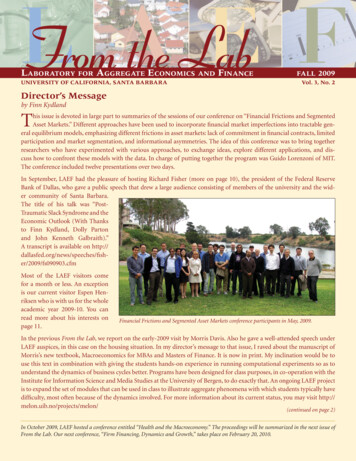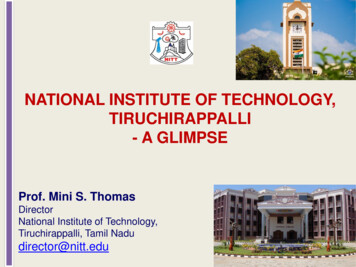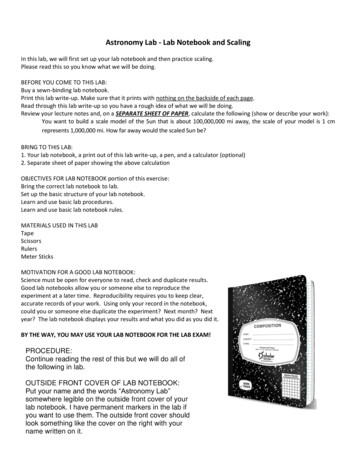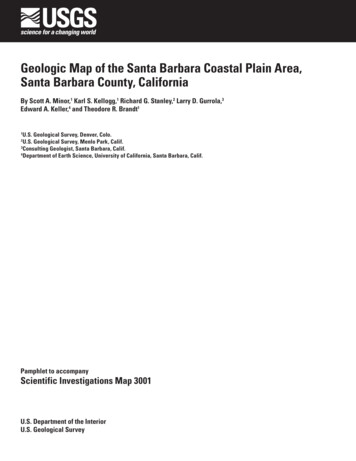
Transcription
From the LabLaboratory for Aggregate Economics and FinanceUNIVERSITY OF CALIFORNIA, SANTA BARBARAfall 2009Vol. 3, No. 2Director’s Messageby Finn KydlandThis issue is devoted in large part to summaries of the sessions of our conference on “Financial Frictions and SegmentedAsset Markets.” Different approaches have been used to incorporate financial market imperfections into tractable general equilibrium models, emphasizing different frictions in asset markets: lack of commitment in financial contracts, limitedparticipation and market segmentation, and informational asymmetries. The idea of this conference was to bring togetherresearchers who have experimented with various approaches, to exchange ideas, explore different applications, and discuss how to confront these models with the data. In charge of putting together the program was Guido Lorenzoni of MIT.The conference included twelve presentations over two days.In September, LAEF had the pleasure of hosting Richard Fisher (more on page 10), the president of the Federal ReserveBank of Dallas, who gave a public speech that drew a large audience consisting of members of the university and the wider community of Santa Barbara.The title of his talk was “PostTraumatic Slack Syndrome and theEconomic Outlook (With Thanksto Finn Kydland, Dolly Partonand John Kenneth Galbraith).”A transcript is available on 90903.cfmMost of the LAEF visitors comefor a month or less. An exceptionis our current visitor Espen Henriksen who is with us for the wholeacademic year 2009-10. You canread more about his interests onpage 11.Financial Frictions and Segmented Asset Markets conference participants in May, 2009.In the previous From the Lab, we report on the early-2009 visit by Morris Davis. Also he gave a well-attended speech underLAEF auspices, in this case on the housing situation. In my director’s message to that issue, I raved about the manuscript ofMorris’s new textbook, Macroeconomics for MBAs and Masters of Finance. It is now in print. My inclination would be touse this text in combination with giving the students hands-on experience in running computational experiments so as tounderstand the dynamics of business cycles better. Programs have been designed for class purposes, in co-operation with theInstitute for Information Science and Media Studies at the University of Bergen, to do exactly that. An ongoing LAEF projectis to expand the set of modules that can be used in class to illustrate aggregate phenomena with which students typically havedifficulty, most often because of the dynamics involved. For more information about its current status, you may visit http://melon.uib.no/projects/melon/(continued on page 2)In October 2009, LAEF hosted a conference entitled “Health and the Macroeconomy.” The proceedings will be summarized in the next issue ofFrom the Lab. Our next conference, “Firm Financing, Dynamics and Growth,” takes place on February 20, 2010.
Director’s Message (continued)Twice before, I have reported on the outcomes of panel meetings organized by the Copenhagen Consensus Center. The purpose of these meetings is to rank, in terms of benefit-cost ratios, solutions to major problem areas. The first meeting in whichI participated dealt with Latin-American solutions, and the second with solutions to world problems. Then, in September,I participated in the Copenhagen Consensus on Climate, on a panel with Jagdish Bhagwati, Thomas Schelling, Vernon Smith,and Nancy Stokey. As always before the panel meeting, experts had been assigned to propose and evaluate solutions in different areas, in this case eight possible areas: carbon cuts, forestry, black carbon cuts, methane cuts, adaptation, technology-ledpolicy, climate engineering, and technology transfers. In the end, we had 15 solutions to rank. Some were extremely longrange solutions. Others were aimed at keeping temperatures from rising too much while the long-range solutions are beingdeveloped. Ranked number one and three were two solutions in the latter category: research on marine cloud whitening,and stratospheric aerosol insertion research. They may sound rather exotic, perhaps even far-fetched to some, but the panelwas convinced by the experts that if these solutions don’t have side effects to speak of, the potential for them to contribute tokeeping temperature increases within reason at low costs is very promising.Number two in the ranking is energy technology R&D (in fact, the top four solutions all involved research), which obviouslyaims to deal with global warming in the long run. This research, according to the proposal, would be financed by a carbontax that starts out low, but then grows exponentially. In addition to financing research directly, the idea is that the resultingneed to consider the growing cost of carbon emission in the future would provide incentives for the private sector to makeinvestments in green technologies sooner rather than later. A big question, of course, is whether such a time path for the taxrate is politically credible.Especially interesting to me is the Technology Transfers (TT) solution. A week before the panel meeting, after having readall the papers, the panel members were asked to make a preliminary ranking. In this ranking, I had TT as number one. Sucha high ranking in part reflects my general economic belief that there is a lot of technological knowledge available in generalwhich can be transferred to less-developed nations. Making use of it, perhaps with the addition of some research and development to adapt to the local circumstances, is how those nations can hope to make progress in narrowing the income gap with the more well-to-do nations. So why wouldn’tLaboratory forsomething like that work also in the context of technology to abate global warming?Aggregate Economicsand FinanceIn my notes after reading the experts’ papers, I had jotted down a few questions forFinn Kydlandthem. The main problem to me and, as it turned out, to the other panel members asDirectorwell, was the lack of concreteness. The whole thing seemed too much like a “black box.”Peter RupertAssociate DirectorWe wanted to know in much greater detail how it would work in practice. The expertsCarmen Earlehad emphasized, for example, the importance of technology transfers to shift the marBusiness Managerginal cost curve rather than moving along it. What are examples of such technology2112 North Hallimprovements? We also had issues with the political implementability of the solution.University of California,Santa BarbaraWe even called the presenters back for further questioning, but in the end, I, at least, feltSanta Barbara, CA 93106-9215too many of our questions by and large were still unanswered. As a consequence, this, toU.S.A.Phone: (805) 893-2258me initially very promising, solution ended up only number seven (virtually tied withFax: (805) 893-8830Email: carmen@econ.ucsb.eduthe solution in sixth place) in our ranking.www.laef.ucsb.eduSpecial thanks go to RachelMoore, UCSB Economics Ph.D.student, for her accurate andconcise summaries of each of theconference presentations,Michael Oliva for the photography,and UCSB Artworks inInstructional Development fornewsletter design and production.2Many of the issues discussed during the panel meeting are obviously in great need of further research. It seems to me this need is especially urgent in the case of the TT solution.Perhaps, in the end, it will turn out that my initial ranking was quite appropriate anyway!For more detailed information about the panel meeting, including the expert papers,you can visit http://www.copenhagenconsensus.com/CCC Home Page.aspx
Financial Frictions and Segmented Asset MarketsMAY 1-2, 2009In May 2009, the Laboratory for Aggregate Economics and Finance sponsored a conference entitled “Financial Frictions and Segmented Asset Markets.” The conference organizers were UCSB Economics professor Peter Rupert andChristian Zimmermann, Associate Professor of Economics at the University of Connecticut. Professor Rupert alsoserves as Associate Director of the Laboratory for Aggregate Economics and Finance.The conference included twelve presentations over two days. UCSB Economics Department faculty and graduatestudents participated.VISITING CONFERENCE PARTICIPANTSV.V. Chari – University of Minnesota andthe Federal Reserve Bank of MinneapolisJoão Gomes – University of PennsylvaniaZhiguo He –University of Chicago – BoothHugo Hopenhayn – University of California,Los AngelesWeerchart Tee Kilenthong – University of California,Santa BarbaraYong Kim – University of Southern CaliforniaNobuhiro Kiyotaki – PrincetonPaul Klein – University of Western OntarioArvind Krishnamurthy – Northwestern – KelloggGuido Lorenzoni – MITGuillermo Ordoñez Yale and the Federal ReserveBank of MinneapolisLukas Schmid – DukeYongseok Shin – Washington University, St. LouisJae Sim – Federal Reserve BoardPierre-Olivier Weill – University of California,Los AngelesSummaries of each of the presentations follow. Note that speakers are highlighted in author listings.FRIDAY, MAY 1, 2009SATURDAY, MAY 2, 2009Intermediary Asset PricingZhiguo He and Arvind KrishnamurthyConfronting Models of Financial Frictionswith the DataPatrick Kehoe and V.V. ChariAggregate Implications of MicroAsset Market SegmentationChris Edmond and Pierre Olivier WeillTsunamiYong KimUncertainty, Credit Spreads, andInvestment DynamicsSimon Gilchrist, Jae Sim and Egon ZakrajšekLiquidity, Business Cycles, andMonetary PolicyNobuhiro Kiyotaki and John MooreEquilibrium DefaultHugo Hopenhayn and Iván WerningProductivity Growth and Capital Outflow:The Case of a Small Opening EconomyFrancisco Buera and Yongseok ShinLarger Crises, Slower Recoveries:The Assymetric Effects of Financial FrictionsGuillermo OrdoñezEquilibrium Credit Spreads andthe MacroeconomyJoão Gomes and Lukas SchmidMarket Based, Segregated Exchangesin SecuritiesWeerchart T. Kilenthong and Robert M. TownsendCredit Crises and Liquidity TrapsGuido Lorenzoni and Veronica Guerrieri3
Financial Frictions and Segmented Asset MarketsIntermediary Asset PricingP R E S E N TAT I O N S U M M A R I E SIntermediary Asset Pricing, p. 4by Zhiguo He and Arvind KrishnamurthyAggregate Implications of Micro AssetMarket Segmentation, p. 5by Chris Edmond and Pierre-Olivier WeillTsunami, p. 5by Yong KimUncertainty, Credit Spreads, and InvestmentDynamics, p. 6by Simon Gilchrist, Jae Sim and Egon ZakrajšekLiquidity, Business Cycles, and MonetaryPolicy, p. 6by Nobuhiro Kiyotaki and John MooreEquilibrium Default, p. 7by Hugo Hopenhayn and Iván WerningConfronting Models of Financial Frictionswith the Data, p. 7by Patrick Kehoe and V.V. ChariProductivity Growth and Capital Outflow:The Case of a Small Opening Economyp. 8by Francisco Buera and Yongseok ShinLarger Crises, Slower Recoveries:The Assymetric Effects of Financial Frictionsp. 8by Guillermo OrdoñezEquilibrium Credit Spreads and theMacroeconomy, p. 9by João Gomes and Lukas SchmidMarket Based, Segregated Exchangesin Securities, p. 9by Weerachart T. Kilenthong andRobert M. TownsendCredit Crises and Liquidity Traps, p. 9by Guido Lorenzoni and Veronica Guerrieri4by Zhiguo He and Arvind KrishnamurthyHe and Krishnamurthy create a model to study the dynamics ofrisk premia in the event of an asset market crisis. The authorsexplain two phenomena: the nonlinearity of risk premia during crisis episodes and the speed of adjustment in risk premiafrom a crisis back to pre-crisis levels. In an environment wherehouseholds must use the services of an intermediary to investin risky assets, moral hazard limits the amount households caninvest. Household investment must be met by some proportionof intermediary investment, making possible household investment increasing in intermediary capital. Specialists put all theirwealth in the intermediary, and make the portfolio decisions.The marginal investor prices risk rather than a representativehousehold doing so. When the household investment constraint binds, indirect household investment in the risky assetfalls, so the specialist increases exposure to the risky asset. Theprice of the risky asset must fall to induce this type of investment, and expected return rises. When a negative shock occurs,households decrease investment with the intermediary, but therisky asset must still be held by the intermediary sector, so intermediaries borrow from the debt market. The authors modela liquidity crisis by matching the risk premium observed in thedata. The nonlinearity of risk premium during crisis and thespeed of adjustment back to pre-crisis levels are both capturedin this model.Intervention policies analyzed under this framework includecapital infusion, a borrowing subsidy, and direct asset purchase.The first policy is of particular interest as the United StatesTreasury has devoted billions of dollars towards the purchase ofequity capital in response to the current subprime crisis. A numerical example with the calibrated model would predict that a 250bn equity infusion would lower risk premium from 20% to11.2%. The second policy corresponds to the central bank lowering the target for the overnight interbank interest rate. If ratesare already low, this policy cannot be pursued. The third policy,pursued by the United States government in response to the2008 financial crisis, is direct purchase of distressed assets. Thegovernment purchases shares of the risky asset through borrowing. The specialist now bears less risk and the risk premium falls.In effect, the risk is transferred to households. The governmentrebates the households through lump-sum transfers. The equityinfusion is more effective as it hits the problem of liquidity scarcity at its heart, but all three cases are effective in speeding upthe recovery.One conference participant inquired about the importance ofthe risk premium. Krishnamurthy responded that it is not therisk premium itself that is of interest, but its use as a proxy forthe severity of a liquidity crisis. Questions also arose over theuse of an equity friction over debt restrictions. Both householdsand specialists invest in the risky asset, but the households willnever invest more than some proportion of specialist investmentdue to moral hazard. This equity constraint will bind before adebt constraint binds, so debt restrictions would be redundant.When asked why all agents do not pool their wealth and invest,
Financial Frictions and Segmented Asset MarketsKrishnamurthy explained that this is indeed the benchmark,but when the equity constraint binds, households would like toinvest more, but cannot. The specialist must borrow to increasethe capital base required for further household investment.Aggregate Implications of Micro AssetMarket Segmentationby Chris Edmond and Pierre-Olivier WeillWith the goal of understanding asset price fluctuations, Edmond and Weill consider the aggregate implications of a frictional financial system with a consumption-based asset pricingmodel. The majority of models of financial frictions have reliedon one of two approaches – the microfoundations approachand the aggregate approach. The microfoundations approachseems to lack aggregate implications. The alternative aggregateapproach relies on financial frictions faced by an intermediaryor by households. Calibration requires the friction to be large,and may be hard to justify in the real world. This model is ahybrid of the two approaches, taking a standard consumptionbased asset pricing model and segmenting the financial marketinto many smaller markets. Full risk-sharing is prevented bymarket-specific frictions. Each market is defined by an exogenous fraction of investment that must be done by specialistsin that market. The remaining fraction of investment is sharedover all specialists.The economy is made up of families which consist of differentspecialists, which can be interpreted as the partially integratedfinancial system. Each trader must purchase the exogenouslydetermined fraction of the asset of his market, and the remaining amount is shared among the family. This fraction representsthe extent to which a trader cannot fully diversify, and createsa systematic risk. When the fraction of investment required tobe undertaken by the specialist hits zero, the economy collapsesto the standard Lucas-Breeden asset pricing model. The benchmark calibration sets a homogeneous fraction required for allassets, and it requires 21% of agent investment in the local asset.With fractions varying across assets, the average fraction neededacross assets is only 11% to generate the same risk premium.Unlike incomplete market models, where idiosyncratic riskdoes not affect the equity premium, this model generates localstochastic discount factors, and can generate an unconditionalequity premium of 3.7%.A conference participant asked how this model differs from theasset pricing model of Krueger-Lustig, where the independencebetween idiosyncratic shocks implies an aggregate stochasticdiscount factor independent of local shocks. Here, there is aspecialist in each family who holds untradeable risk, leading toa risk correlation between families, so the idiosyncratic component cannot be dropped from the aggregate risk premium.Questions arose as to how the stochastic discount factor is constructed: specifically, whether the usual Euler equation is beingused. Weill replied that decisions, and therefore prices, are madeat the family level. Traders take orders from the family, andeach family forms different prices in response to shocks. Krishnamurthy commented that there might be some inconsistencyif these are considered liquid assets. Some justification for thefriction should be given.Tsunamiby Yong KimKim’s paper seeks to understand fluctuations in asset prices using a search friction framework. The economy consists of a fixedstock of assets and agents transition between three states: buyer,owner and seller. Owners become sellers exogenously and buyers enter the market exogenously. The frictionused for buyers of the asset is adjustment costfluctuations, created by varying the entry rateof buyers. This causes the relative population ofbuyers to sellers to fluctuate, affecting bargainingpower. Fluctuating sales prices result, even whenassessment of asset returns and the interest rateremain constant. Steady state is governed by aconstant market tightness, or the ratio of buyersto sellers. As the price of the asset is a functionof market tightness, asset price will also be constant in steady state. When the inflow of buyerschanges, the tightness parameter changes, andwill adjust as the model returns to steady state.The concavity of the match rate in the markettightness parameter drives interesting out-ofsteady-state results. In the case of high entry,the ratio of buyers to sellers increases. Sellersare matched out faster, further exacerbating theproblem. This implies that the ratio could actually increase before it eventually decreases backto steady state. This divergence before conver5
Financial Frictions and Segmented Asset Marketsgence maps into asset prices, offering an explanation for thehigh variance in asset prices. By focusing on out-of-steady-statedynamics, the impact of the adjustment cost friction can be severe, even if the friction itself is small.The shock is aggregate in the sense that all firms face the sameuncertainty level. However, it does not alter the economy-widemean productivity level, differentiating it from an aggregatetechnology shock.Discussion arose among conference participants over the outof-steady-state dynamics. A crisis occurs because buyers disappear, not because there are too many. Kim agreed that thedynamics in this paper start with an influx of buyers, but emphasized that he is modeling both the boom and the crisis.There must be some phenomenon that raises bid prices beforethey crash. The incredible variation generated in asset priceswas striking and Chari pointed out that the nonlinearity of thematching function was responsible. Kiyotaki noted that quantity does not respond to price, as there is a fixed supply of theasset always held by agents.Investor concern over the return spread arises from the potential for both default and limited liability. When the spread widens, the default probability increases, making capital costlier.This hinders the firm from increasing capital via the traditionalcost channel, but aids investment through the collateral channel, implying that a firm with a strong balance sheet positionwill fare much better when capital becomes costlier during highuncertainty periods. As firms increase their leverage ratios, theprobability of default increases, and the bond price starts to fall.Uncertainty, Credit Spreads, andInvestment Dynamicsby Simon Gilchrist, Jae W. Sim and Egon ZakrajšekPerhaps risk alone is not enough to explain fluctuations in asset prices and investment. The Gilchrist-Sim-Zakrajžek workproposes that some business cycles may be driven by aggregateuncertainty shocks in the face of credit market frictions. Empirically, it is noted that uncertainty regarding return spreadaffects investment independently. Time-varying uncertainty ismodeled by allowing the variance of the persistent idiosyncraticproductivity shock to evolve according to a stochastic process.Agents are not able to observe the aggregate shock, only thefirms’ returns. The authors argue that during a recession, it iseasier for a good firm to do relatively better, and likelier for abad firm to perform worse. This leads to a higher dispersionduring downturns, and independently influences investment.For the calibrated model, an increase of 50-100% in equity issuance results during a high uncertainty regime. The credit riskpremium doubles, matching the empirical elasticity, and the investment-to-capital ratio decreases. Default and recovery ratesare overestimated, leading Chari to suggest that the results fromthis model be compared to one with first moment shocks instead of second moment shocks. The importance of maintaining the mean preserving spread was also debated.Liquidity, Business Cycles, andMonetary Policyby Nobuhiro Kiyotaki and John MooreThe Kiyotaki-Moore model of money and liquidity is meant tofacilitate the understanding of how aggregate production andasset prices fluctuate with shocks. The authors offer an explanation for anomalies such as the risk-free rate puzzle, the excessvolatility of asset prices, savings behavior and low participationin asset markets in an economy where money is essential. Inaddition to money, there exists both physical and human capital. The opportunity to produce new capital arrivesrandomly. There is a need to transfer resources to theentrepreneurs with an opportunity to invest, but thereare two frictions at work. The first is a borrowing constraint; only a fraction of future returns from the newcapital can be pledged. The second is called a resaleability constraint; at any given time, only a fraction ofequity can be sold. In this sense money is more liquidthan equity. Liquidity shocks are the changes in thefraction of sellable equity.A standard assumption is made that the entrepreneurhas to invest a certain amount for each unit of outsideinvestment in his project. Constrained by how much ofhis equity can be sold, an investing entrepreneur trying to make his down payment will find money morevaluable than equity. The gap between these two assetsis the liquidity premium, and may help explain the lowrisk-free rate puzzle. Workers who never have investment opportunities will never hold either asset, explaining low participation in asset markets. More importantly, asset prices and investment are vulnerable tothe liquidity shocks. In response to a negative liquidity6
Financial Frictions and Segmented Asset Marketsshock, a government policy to purchase equity by issuing money can restore the value of assets and expand investment. A fewyears ago, considering such a policy might have seemed strange.Chari commented that the same results could be obtained witha shock to the borrowing constraint. Kiyotaki agreed, and replied that he chose shocks to the resaleability constraint in aneffort to mimic the mortgage-backed securities market. Another participant inquired about solving for the steady-state monetary equilibrium. Kiyotaki pointed out that when shocks areshut down, the model can be solved analytically. He called thisthe onion assumption: The aggregation of assets implies youdon’t have to keep track of the distribution. Even if a layer of anonion is peeled off, it is still an onion.Equilibrium Defaultby Hugo Hopenhayn and Iván WerningMany principle-agent problems address the potential for default, but default never actually occurs in equilibrium with theoptimal contract. Most assume both the principal and agent areable to commit. Hopenhayn’s and Werning’s paper allows fora lack of commitment and imposes the constraints that arisenaturally under private information. Outside opportunitiesavailable to entrepreneurs are always assumed to be less sociallyefficient; thus, with commitment, these opportunities wouldnever be taken. They may be privately efficient, however, andwithout commitment the entrepreneur may take them. The optimal contract will be forward-looking, taking these opportunities into account. Without this asymmetry of information, themodel would collapse to the standard limited commitment casewith either the first-best allocation or no lending at all.Default will still occur along the equilibrium path, but the probability of default will decrease over the life of the principal-agentrelationship. Long-term debt and capital will also rise over time.Two points in particular separate this work from previous literature. First, in this paper, contracts are not restricted to benon-contingent. They are endogenous and derived from theasymmetry of information. Second, relationships are allowed tobe long-term, so that debt can mature. Results can be interpreted similarly for a worker-employer relationship. As the workergains more human-capital specific to her position, the less likelyshe is to walk away from the job.During the conference, questions arose over the consistency ofperiod-by-period zero profit for lenders when the nature of thecontract is such that the lenders receive higher payments earlyon, and lower payments later. The zero-profit condition arisesfrom the competitive lender assumption and the ability to rollover debt. The idea is that an agent can pay off debt to the initiallender by borrowing from a new lender. Competition ensuresthat this new lender will earn zero expected profit. Only initial lenders have the ability to extract a surplus. Furthermore,agents are less likely to be liquidated with possible debt rollover.The result highlights the importance of long-term debt whencontracts cannot be made state-contingent. A participant asked:What would happen if the outside opportunity were observ-able? Without private information, the contracts could be madecontingent on these opportunities, and result in either the firstbest immediately, or no lending.Confronting Models of Financial Frictionswith the Databy Patrick Kehoe and V.V. ChariThe real world has one purpose, and only one purpose for us aseconomists, which is to provide data to calibrate our models.– V.V. ChariWith the abundance of emerging financial friction models thattry to reconcile asset pricing, business cycles, and intermediation, Chari and Kehoe point out that these models must replicate what is observed in the data. The talk started with two observations. First, the average difference between available fundsand capital expenditure is about 2% of GDP. Second, availablefunds almost always exceed capital expenditures. These implythat access to financial markets is not critical for investment decisions. Still, the difference between debt and equity should betaken seriously. Financial markets could play a big role in reallocating funds from cash-rich, project-poor firms to cash-poor,project rich firms. However, this interplay would not be seen inthe aggregate.Another important question addresses the heterogeneity offirms. For instance, are responses to liquidity tightness andrecession different for small and large firms? Chari presentedstrong evidence that financial frictions matter and affect smallfirms more than large firms. Recessions, on the other hand,seem to have an equally negative impact on small and largefirms. Economists need to write a financial frictions modelwhere small firms contract more in response to financial tightening, and all firms fare similarly in response to business cyclefluctuations.Debate ensued among conference participants over varioustypes of investment and debt that may or may not be observable in the data and what it might mean for modeling. The7
Financial Frictions and Segmented Asset Marketsallocation of entrepreneurial talent and capital. However, therise is gradual since domestic financial markets can reallocatecapital only slowly. For this reason, capital will flow out of theeconomy after the reform. The second experiment improvesdomestic financial markets, in addition to eliminating idiosyncratic distortions and liberalizing capital accounts. TFP growsmuch faster than in the previous case and capital immediatelyflows in from overseas. One such example is the experience ofEstonia in the 1990s. The results highlight the importance ofdomestic financial market reforms in conjunction with otherliberalization measures.question was asked: How, exactly, are firms paying for intangible investment like research and development and advertising? Chari answered that a real business cycle model would havethe decrease in intangible investment show up in the total factorproductivity parameter. Participants also wondered if there areother means of raising capital during liquidity shortages, suchas hiring freezes and wage rene
University of California, Santa Barbara Santa Barbara, CA 93106-9215 U.S.A. Phone: (805) 893-2258 Fax: (805) 893-8830 Email: carmen@econ.ucsb.edu www.laef.ucsb.edu Special thanks go to Rachel Moore, UCSB Economics Ph.D. student, for her accurate and concise summaries of each of the conference presentations, Michael Oliva for the photography,











